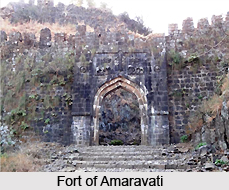 The ancient name of Amravati is `Udumbravati`, and the prakrut form of this is `Umbravati`. The name was simplified as Amravati and it is now known as the same. The name is said to have emerged from the ancient Ambadevi temple situated here. The proof of the existence of Amravati in ancient times can be acquired from a stone carved inscription on the base of a marble statue of God Adinath (Jain God) Rhishabhnath. This shows that, these statues were set up here in 1097.
The ancient name of Amravati is `Udumbravati`, and the prakrut form of this is `Umbravati`. The name was simplified as Amravati and it is now known as the same. The name is said to have emerged from the ancient Ambadevi temple situated here. The proof of the existence of Amravati in ancient times can be acquired from a stone carved inscription on the base of a marble statue of God Adinath (Jain God) Rhishabhnath. This shows that, these statues were set up here in 1097.
It has been seen from historical evidence that in the 14th century, there was famine (drought) in Amravati and the people abandoned Amravati and left for Gujarat and Malwa. The local people returned back after several years at Amravati, and the result of this was scanty population in the district. In 16th century, Mager Aurangpura (today`s, `Sabanpura`) was presented for building the Jumma Masjid by Badashah Aurangzeb. This reveals that Muslims and Hindus lived together here. In 1722, Chhatrapati Shahoo Maharaj presented Amravati and Badnera to Shri Ranoji Bhosle. By this time Amravati was known as Bhosle ki Amravati. The city was reconstructed and prospered under the rule of Ranoji Bhosle after the treaty of Devgaon and Anjangaon Surji and the consequent victory over Gavilgad (Fort of Chikhaldara).
The city of Amravati came into existence at the end of the 18th century. Union state of Nizam and the Bhosles was in existence here. They appointed a revenue officer as well. However the defences of the district were in a bad state. Gavilgad fort was conquered by the British on 15th December 1803
Under British rule, a number of constructions took place in the district and it was modernised. From 1859 to 1871, many government buildings came into existence, which were built by them. Railway station was constructed in 1859, Commissioner`s Bungalow in 1860, Small cases court in 1886, (today`s S.D.O. Office), the Tehsil office and the Main post office were built in 1871. During this time, the central jail, collector`s office, Rest house and the cotton market was also built. During 1896, Shri Dadasaheb Khaparde, Shri Ranganath Pant Mudhodker, Sir Moropant Joshi, Shri Pralhad Pant Jog were the leaders in Amravati. The 13th Congress Conference was held at Amravati on 27-29 December 1897 due to the efforts of these leaders. Shri Lokmanya Tilak and Shri Mahatma Gandhi visited Amravati in 1928.
In 1853, the present day territory of Amravati district as a part of Berar Province was assigned to the British East India Company, following a treaty with the Nizam of Hyderabad. After the Company took over the administration of the province, it was divided into two districts. The present day territory of the district became part of North Berar district, with headquarters at Buldana. Later, the province was reconstituted and the territory of the present district became part of East Berar district, with headquarters at Amraoti. In 1864, Yavatmal District (initially known as Southeast Berar district and later Wun district) was separated. In 1867, Ellichpur District was separated but in August, 1905, when the whole province was reorganized into six districts, it was again merged into the district. In 1903, it became part of the newly constituted province of Central Provinces and Berar. In 1956, Amravati district became part of Mumbai state and after its bifurcation in 1960; it became part of the state of Maharashtra.






